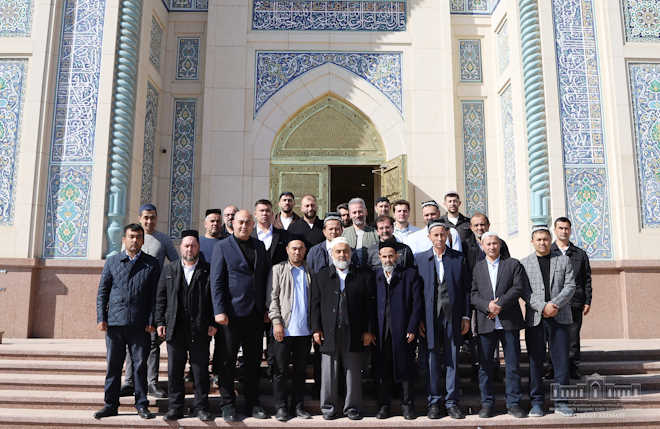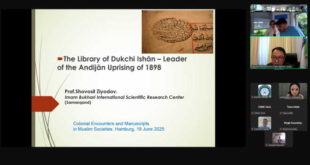The Imam Bukhari International Scientific Research Center was visited by a group of Turkish and local practitioners and researchers under the leadership of the head of the “Islamic Civilization” Park in Istanbul, the famous calligrapher and renowned Islamic scholar Hüseyin Kutlu.

Deputy Director Otabek Muhammadiyev acquainted the guests with the Museum of the Center and informed about the results of scientific activities.
During the visit, guests, scientific staff of the Center, local calligraphers and young people interested in this type of art participated in a round discussion on the topic “The art of calligraphy, ancient manuscript copies of the Holy Qur’an: copies of Mus’hafi Sharif from the Ghaznavid, Timurid and Baburi periods.”

The Turkish scholar spoke about the art of calligraphy, its various directions and its high significance as a cultural heritage.
Hüseyin Kutlu is one of the most prominent representatives of the modern Turkish calligraphy school. As a student, he developed a love for the science of writing and gradually became a mature specialist in the field. Now, having created his own school, he teaches many young people the secrets of this elegant art.
At the roundtable discussion, the scientist presented the Istanbul Mus’hafi, which he copied based on the 1500-year-old tradition of calligraphy and book art. This 10-volume manuscript includes examples, styles and decorations of the art of reading and calligraphy, which continued from the time of the Prophet (peace be upon him) to the beginning of the 20th century. In particular, it contains examples of letters and decorative motifs from the Saadat era, Companions, Samanids, Karakhanids, Seljuks, Ghaznavids, Mamluks, Ottomans, Elkhanids, Timurids, Safavids, Qajars, Afshars, Baburids, as well as the years after the declaration of the republic in Turkey.

Hüseyin Kutlu worked on this manuscript with more than 60 students for 8 years. During this time, he collected materials and raw materials from various regions of the Muslim world. In particular, the bark of trees growing in the shrines of Samarkand and Bukhara was used in the preparation of manuscript paper. In the copy of the Holy Quran copied by Hüseyin Kutlu, gilded paints made of a mixture of gold were also used.
Continuing the ancient and enchanting calligraphy traditions of Turkey, Hüseyin Kutlu is known not only in Turkey but also internationally for his creativity and mastery. He does not view calligraphy as a mere profession, but perceives it as spiritual nourishment and work of the soul. In his words, he emphasizes not only the aesthetic value of calligraphy, but also its great spiritual value. This art, which leads a person to inner perfection and stability, explains that it requires patience and attention.
Hüseyin Kutlu is trying to combine traditional calligraphy with modern requirements and teach it to the new generation. This shows his great contribution to the development of the culture of the Ummah and further increases the importance of calligraphy in the modern Islamic world. According to him, through this art, people learn not only writing, but also spiritual purification.
At the roundtable discussion, the scientist emphasized the importance of passing down the cultural heritage through calligraphy and ensuring the preservation of this art in the future.


Samples of modern calligraphy art of Samarkand were presented as part of the event. The Turkish guest gave suggestions and recommendations to local calligraphers and gave a master class.
 Imom Buxoriy xalqaro ilmiy-tadqiqot markazi bukhari.uz
Imom Buxoriy xalqaro ilmiy-tadqiqot markazi bukhari.uz












